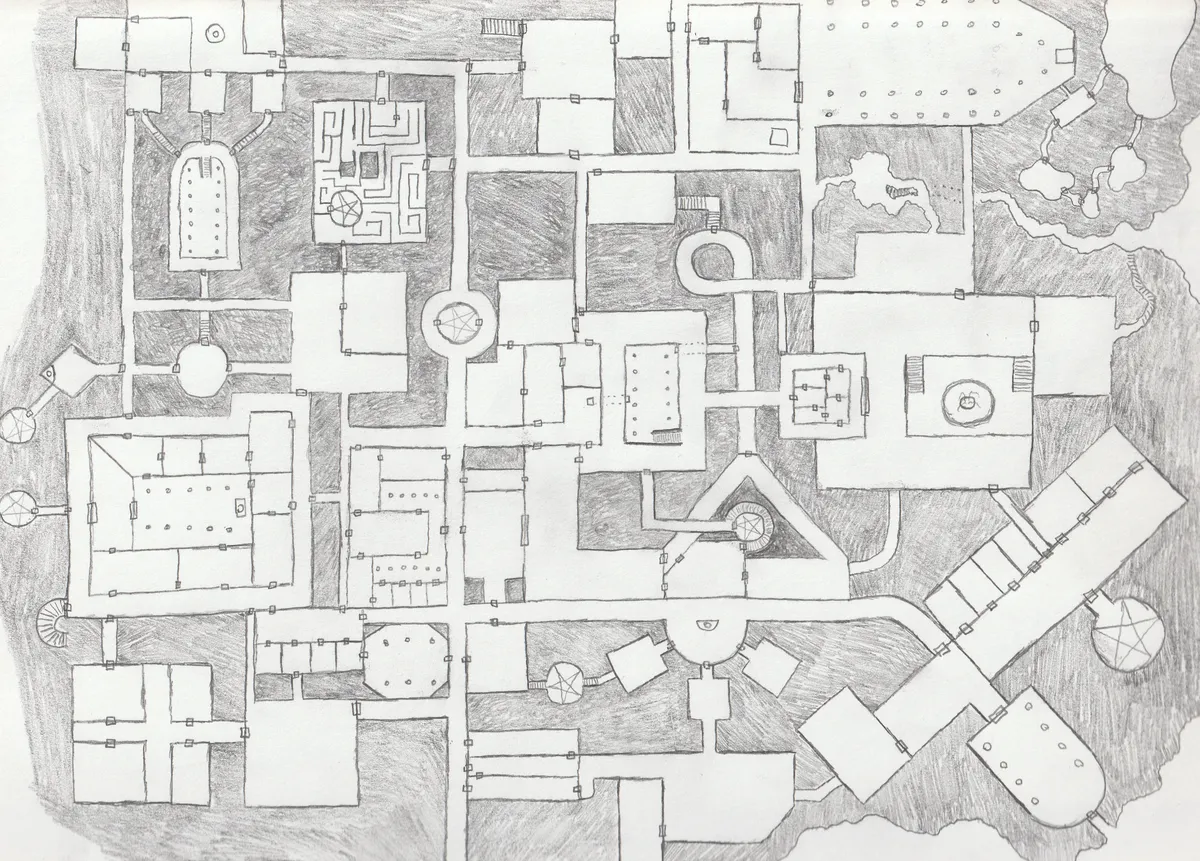Quick & Dirty Megadungeon Stocking
I like the idea of using dungeon stocking procedures but usually find them fiddly & time-consuming. I also find it hard to limit myself to procedural generation when I spend so much free time reading the amazing ideas people share on their blogs. But, I'm reluctant to hand-stock dungeons without including some random, impartial element.
So here's the procedure I came up with to stock my OD&D megadungeon -- it's not rigorous about balance or impartiality, but it's quick & front-loads the ideas I'm most excited about:
- Draw or acquire a large map. Number each room or distinct location.
- Make a big list of unique things you want to throw at your players. Monsters, unique treasures, magic items, tricks, puzzles, traps, NPC, details. If possible, group these thematically, or start with the groupings and work outward. Try [fantasy/sci-fi trope] + [type of place or event], e.g. fairy school, goblin drug lab, wizard's kitchen, alien museum, skeleton wedding.
- For each room on the map, roll a d6 and mark the room on 1.
- For each marked room, go through your list from step 2 and pick something to place there (or number them & roll randomly -- we live in the 21st century so it's ok to use a computer to roll a d42 or whatever), then cross it off. Go back and add items if needed, and try to place grouped items near each other. Place the toughest monsters and best treasures in remote areas.
- Now, go through the unmarked rooms and roll a d6: 1-3: thing related to a nearby marked room 4: random monster or treasure from the OD&D tables, 5: random dressing or detail 6: truly empty. For rolls of 1-3, try to pick something that complements what's in the nearby marked room -- if the marked room has an owlbear, the nearby rooms might have owlbear droppings & pellets, or horrifically gored adventurers (& the loot they collected), or the hobgoblins keeping it as a pet. The goal here is for the spicy details you cooked up in step 2 to 'bleed out' to nearby rooms. Put MONSTER or TREASURE or TRAP in all caps as a placeholder if you know you want one there but can't come up with the specifics.
- Ctrl-F for placeholders. If you still can't think of something to fill in, grab a random game from your embarrassingly huge RPG collection and use its tables, or leave it to be filled in on the fly.
- Run a quick audit. Is there enough treasure to level up adventurers? (If not, start adding sacks of coins to existing room descriptions). Are there any factions or conflict areas? (Consider explicitly writing up their goals and leadership structure).
- Mark all the rooms with monsters & traps on the map (this helps avoid accidentally letting players blunder past danger)
- Add in some clues and treasure maps pointing to the bigger treasure caches.
The core of this approach is in steps 2 & 4, so I'll elaborate a little. I have an overwhelming number of resources in the form of RPG rules, published adventures to steal from, bookmarked blog posts, and my own idea notebooks. On the other hand, time is scarce, both for designing and playing. Iterating on 2d6 skeletons & +1 swords doesn't feel like a good use of limited hours, so I try to anchor the stocking process with the best, punchiest ideas I've extracted from all my extra-curricular reading.
My only inclusion criteria for the step 2 list is a desire to see it in play, so it embraces NPCs, treasures, monsters, puzzles, & imagery. If I read an adventure or blog and go "ooh, that's cool" it goes on the list. HOWEVER, I try to focus on including treasure, traps, and puzzles. Treasure (in an OSR game) is the main reward and should be plentiful (it's also good for sparking creativity, since unusual treasure demands a backstory). Traps need to be signaled ahead of time to adjudicate fairly. Puzzles are hard to improvise. Monsters, on the other hand, will at a bare minimum be covered by the wandering table(s).
Making the list ahead of time offers a chance for additional curation or adjustment before slotting things into the key. It also doubles as a useful random table for improvisation if I don't get around to keying all the rooms.
The intent of step 4 is to strike a balance between 'Gygaxian naturalism' and 'Mythic Underworld', while favoring the latter. Like a looser version of my glass bead worldbuilding post, free association 'bleeds' conceptually dense ideas into neighboring rooms to create semi-intelligible 'zones' without subordinating the dungeon to a totalizing rationale.
